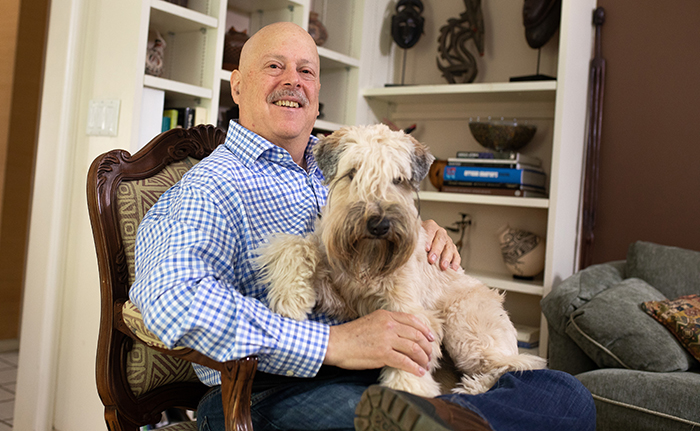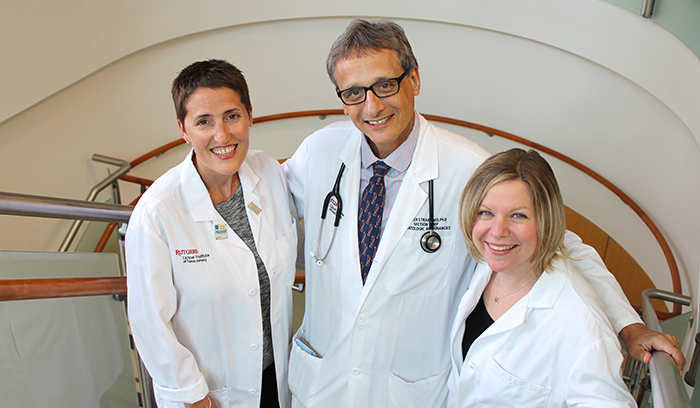Story by Mary Ann Littell • Portraits by John O'Boyle View the complete magazine | Subscribe to Cancer Connection
What happens when the physician becomes the patient? Facing a rare, aggressive blood cancer, Dr. Douglas Krohn turned to an experienced bone marrow transplant team at Rutgers Cancer Institute of New Jersey to get him back on track.
Family medicine physician Douglas Krohn, MD, will tell you his world turned upside down when he faced a life-threatening illness: acute myeloid leukemia (AML), a rare, aggressive cancer of the blood and bone marrow. "I had a wonderful, busy life. I saw patients, puttered around the house, ran errands, and walked the dog," he says. "Then suddenly I was flat on my back in the hospital, unable to do anything."
A bone marrow transplant saved his life, but recovery has been a tremendous challenge. While the gift of new, bone-forming stem cells offers a chance for a cure, the side effects are grueling. “My recuperation is slower than I expected, but I’m thankful to be where I am today,” says Krohn.
Originally from El Paso, Texas, Krohn came to New York City for his medical training, met his wife Monique on a blind date, and never looked back. He established and ran the Piscataway Dunellen Family Practice and the couple raised their two children in Basking Ridge. Avid supporters of the arts, they’re also inveterate travelers, particularly Monique. “When the travel bus pulls up, Monique grabs her bag, jumps on, and then says, ‘Where are we going?’” Krohn quips.
Krohn is on the attending staff at Robert Wood Johnson University Hospital Somerset, an RWJBarnabas Health facility and is a member of RWJ Physician Enterprise (RWJPE), which is part of the RWJBarnabas Health medical group. Now 65, he shows no interest in retiring. Before cancer, he worked a hefty schedule – 40, 50, or even more hours a week – and enjoyed every minute. “My work has been my life, and my life has been my work,” he says.
His diagnosis came as a shock. Attending a concert with a friend on Mother’s Day 2017, he was exhausted and breathless after the short walk from the car to the auditorium. “I thought, ‘Something’s wrong. Better get this checked out,’” he says. “Hard-headed male that I am, I did nothing about it that next day—just went to work as usual.”
The following morning he was again short of breath. At his office he asked Jennifer Smith, his longtime nurse practitioner, to do some blood tests. “I was off the next day and she called me at home,” says Krohn. “The tests showed significant abnormalities that had to be checked out. Of course, I protested, but she’d already sent the results to an oncologist.”
A bone marrow test was performed and Krohn received devastating news: He had either early AML or advanced myeloid dysplastic syndrome (MDS), a group of bone marrow disorders in which the marrow does not produce enough healthy blood cells. In about one-third of patients, MDS progresses to AML.

Douglas Krohn and his trusty companion Parker
With a seriously weakened immune system, to say nothing of a seriously weak body, Krohn stopped seeing patients. His oncologist said he needed the “big guns,” and Krohn was referred to Dale Schaar, MD, PhD, hematologist/oncologist at Rutgers Cancer Institute of New Jersey and associate professor of medicine at Rutgers Robert Wood Johnson Medical School.
“Based on his test results, there was no doubt in my mind that he had AML,” says Schaar, who has spent his career at Rutgers Cancer Institute treating patients with blood cancers and doing research to find improved therapies. “His disease came about quickly, without a history of abnormal blood counts. I compare this diagnosis to being struck by lightning – that’s how acute it is.”

Dale Schaar, MD, PhD, has spent his career at Rutgers Cancer Institute treating patients with blood cancers and doing research to find improved therapies: "Doug Krohn's disease came about quickly, without a history of abnormal blood counts. I compare this diagnosis to being struck by lightning - that's how acute it is." Credit: Steve Hockstein
When considering all age groups, AML affects 3 to 4 persons per 100,000 individuals annually; however, it occurs more frequently in older adults with a median age of 65 years. “This diagnosis is a life-changer,” says Schaar. “AML is particularly hard to treat in older patients because they often have existing underlying medical problems and their AML tends to have more serious prognostic characteristics.”
Schaar told Krohn that a bone marrow transplant was his best hope for recovery. Rutgers Cancer Institute, in conjunction with Robert Wood Johnson University Hospital New Brunswick, an RWJBarnabas Health facility, is one of only two centers in the state to offer this procedure and the only program in the state at a National Cancer Institute (NCI)-designated Comprehensive Cancer Center. “As tough as the disease is, the treatment is equally tough,” Schaar explains. “Not long ago, we didn’t even consider bone marrow transplant for patients over 55. But today, many patients 60 and older benefit from transplant. I felt he’d be a good candidate because he’s medically fit and active.”
Seeking a second opinion, Krohn met with specialists at two of New York City’s premier academic health centers. Additional tests were performed. One physician diagnosed him with AML, while the other said more tests were required to rule out MDS. “Hearing the two diagnoses was very confusing,” admits Krohn. “I didn’t know what to do.”
He also worried about how his practice would survive if he had to be out on extended medical leave. With the support of leadership from RWJPE, Krohn was assured him that a physician would be brought into the practice for the duration of his treatment. “What a tremendous relief that was,” says Krohn.
A colleague suggested that Krohn speak with Roger Strair, MD, PhD, chief of blood disorders at Rutgers Cancer Institute who has been at Rutgers the center since it opened its doors. Strair has built the Hematologic Malignancies and Hematopoietic Stem Cell Transplant Programs into nationally recognized centers of excellence.

Douglas Krohn and wife Monique traveled to California in late May to visit their son. "This huge milestone definitely showed me I'm on the path to recovery," he says.
"I met Roger Strair in the lobby. We sat on a sofa and chatted," says Krohn. "He'd seen all my test results and said there was no doubt this was AML. His team had a wealth of experience and good results in treating this disease. I was impressed by his confidence and straightforwardness. After discussing the options with Monique, I decided to have my treatment at Rutgers Cancer Institute."
Krohn's transplant involved a three-step process. First, induction chemotherapy was administered to kill the abnormal cells, producing a complete remission. For this phase of treatment Krohn was hospitalized for more than 40 days. "I was very sick," he says. "Then it just became debilitating, a psychological diminution of yourself. I was becoming smaller and smaller, less capable of doing things. I was so anxious. As a doctor, I had a little knowledge, and that's a dangerous thing."
After a few weeks of recovery he underwent consolidation therapy - more chemotherapy to decrease the chances of recurrence. The final phase of treatment was the bone marrow transplant. A donor had been lined up, but subsequently backed out, giving Krohn a scare. Fortunately a second donor was located. (For more on the donor process, see below.) He received the transplant in late November 2017. "It was anticlimactic," he says. "It's just like a blood transfusion, only the bag is smaller. But that small bag of blood saved my life."
Krohn is slowly regaining his strength. The treatment took its toll and he's thirty pounds lighter ("…not necessarily a negative," notes his wife). Still in recovery mode, he's adapting to "the new normal. Stairs are no longer my enemy and I can walk the dog and not feel exhausted," He takes immunosuppressant medicines to enable the donor cells to establish themselves. "Sadly, no more hospital or nursing home visits, but in view of my age and health, I'm okay with that," he notes.
He and Monique traveled to California in late May to visit their son. "This huge milestone definitely showed me I'm on the path to recovery," he says. In another milestone, he returned to part-time work in June at his physician practice. "I'm thrilled to be back, hoping part-time becomes full-time."
"Doug Krohn is doing well," says Schaar. "As difficult as it was, he came through relatively free of complications. Bone marrow transplant is not for every patient, because of the underlying toxicities and complications. But today more patients are potential candidates due to advancements in stem cell transplantation.
"We need to get the word out about this procedure's great benefits and the need to have it done at an NCI-designated Comprehensive Cancer Center like Rutgers Cancer Institute," he adds. "Studies indicate that only a minority of patients older than age 60, perhaps as few as 15 percent, consult with a transplant team. The message for these patients is: Be evaluated for a transplant. It may save your life." ■

Transplant coordinators Jacqueline Manago, BSN, RN, BMTCN (left) and Mary Kate McGrath, ANP-BC, BMTCN, OCN, with Chief of Blood Disorders Roger Strair, MD, PhD. Credit: Debbie Vogel
Behind the Scenes
"Transplant coordinators are the stars in managing this complex process," says Rutgers Cancer Institute hematologist/oncologist Dale Schaar, MD. "They work behind the scenes, managing HLA (tissue) typing data, doing searches, and ultimately identifying suitable donors."
Rutgers Cancer Institute's transplant coordinators, Jacqueline Manago, BSN, RN, BMTCN, and Mary Kate McGrath, ANP-BC, BMTCN, OCN, are tapped into donor databases worldwide. "HLA typing is a tissue-typing test that helps us identify the best donor for a patient," says McGrath. "Sometimes a family member can be a donor. If not, we look for an unrelated donor. Other options include stem cells from umbilical cord blood or even a half-matched sibling or child using advancing transplant methodologies."
The coordinators run the HLA test results through 'Be the Match' and other databases. The donor networks are international, so a donor can be from anywhere in the world. Donor stem cells are transported and delivered by courier.
"We provide extensive patient education, teach a class outlining the procedure and its risks, so patients are prepared," says Manago, herself a cancer survivor. "A dietitian, social worker, and patient panel make presentations too." Coordinators continue to see patients through pre-transplant treatment and for months and even years after the transplant.
The Rutgers Cancer Institute's Blood and Marrow Transplant Program performs about 130 bone marrow transplants a year and is the only such program in New Jersey that is part of an NCI-designated Comprehensive Cancer Center. "This team approach is what makes us unique," says Dr. Schaar. "We have multidisciplinary specialists, clinical trials, and high-tech genetic testing, which helps plan future treatments. We offer assistance on insurance and financial issues as well - anything that benefits patients."


